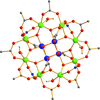issue contents
March 2015 issue

Cover illustration: Seven cocrystal structures of 6-methyl-2-thiouracil with coformers containing the 2,4-diaminopyrimidine substructure are presented. In six of the structures, the acceptor-donor-acceptor/donor-acceptor-donor N-H O/N-H
O/N-H N/N-H
N/N-H S synthon is observed and in only one structure is an acceptor-donor/donor-acceptor interaction formed instead. See Hützler & Egert [Acta Cryst. (2015), C71, 229-238].
S synthon is observed and in only one structure is an acceptor-donor/donor-acceptor interaction formed instead. See Hützler & Egert [Acta Cryst. (2015), C71, 229-238].
research papers




























 journal menu
journal menu































